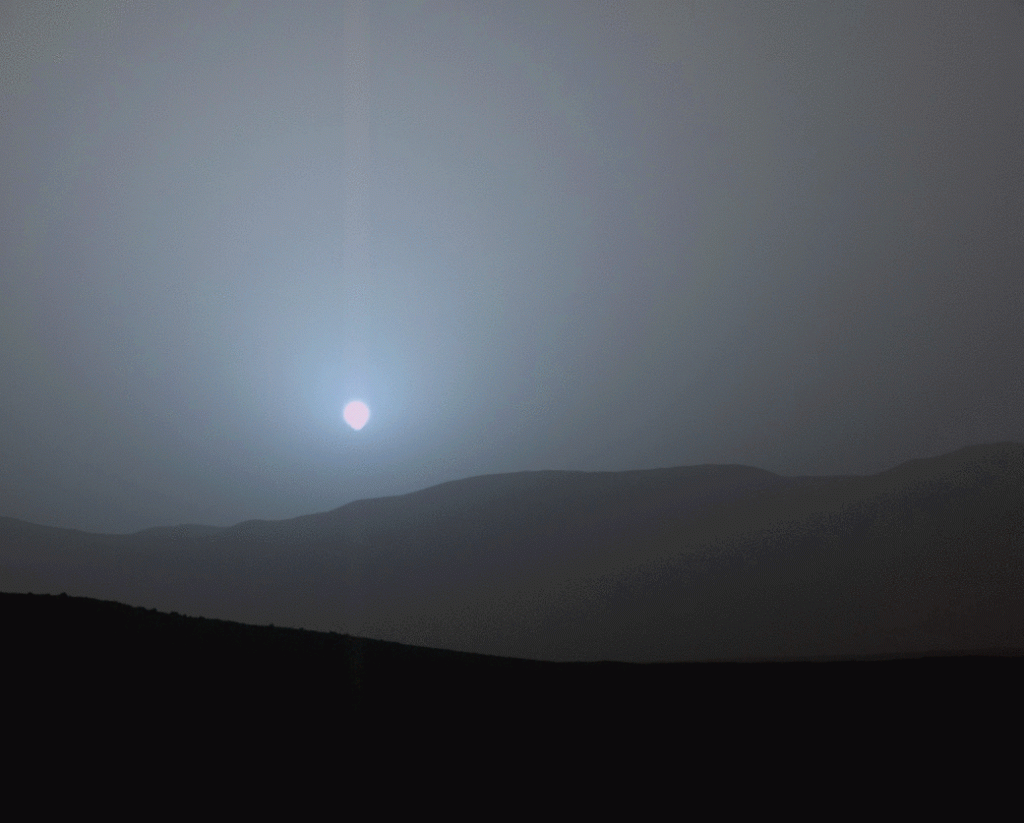
Credit: NASA/JPL-Caltech/MSSS/Texas A&M Univ.
Clicca qui per vedere l’animazione – Click here to see the animation
Il rover della NASA Curiosity su Marte ha registrato questa sequenza di immagini che ritraggono il tramonto alla fine del 956° giorno marziano della missione, il 15 aprile 2015, dalla posizione del rover presso il Gale Crater.
Le quattro immagini mostrate in sequenza sono state scattate in un arco di 6 minuti e 51 secondi. Questo è stato il primo tramonto osservato a colori da Curiosity. Le immagini provengono dalla telecamera di sinistra del Mast Camera del rover (MastCam). Il colore è stato calibrato e bilanciato sui bianchi per rimuovere gli artefatti della fotocamera. La MastCam vede il colore in maniera molto simile a quello che vedono gli occhi umani, anche se in realtà è un po’ meno sensibile al blu rispetto alle persone. La polvere nell’atmosfera marziana ha polveri sottili che permettono alla luce blu di penetrare l’atmosfera in modo più efficiente rispetto ai colori a più lunghezze d’onda. Questo fa sì che il colore blu nella luce mista proveniente dal sole resti più vicino alla parte del sole stesso nel cielo, rispetto alla più ampia dispersione dei colori del giallo e rosso. L’effetto è più pronunciato in prossimità del tramonto, quando la luce del sole passa attraverso un percorso più lungo nell’atmosfera di quanto non faccia a mezzogiorno.
NASA’s Curiosity Mars rover recorded this sequence of views of the sun setting at the close of the mission’s 956th Martian day, or sol (April 15, 2015), from the rover’s location in Gale Crater.
The four images shown in sequence here were taken over a span of 6 minutes, 51 seconds. This was the first sunset observed in color by Curiosity. The images come from the left-eye camera of the rover’s Mast Camera (Mastcam). The color has been calibrated and white-balanced to remove camera artifacts. Mastcam sees color very similarly to what human eyes see, although it is actually a little less sensitive to blue than people are. Dust in the Martian atmosphere has fine particles that permit blue light to penetrate the atmosphere more efficiently than longer-wavelength colors. That causes the blue colors in the mixed light coming from the sun to stay closer to sun’s part of the sky, compared to the wider scattering of yellow and red colors. The effect is most pronounced near sunset, when light from the sun passes through a longer path in the atmosphere than it does at mid-day.
Source/Continue reading → NASA.gov





















